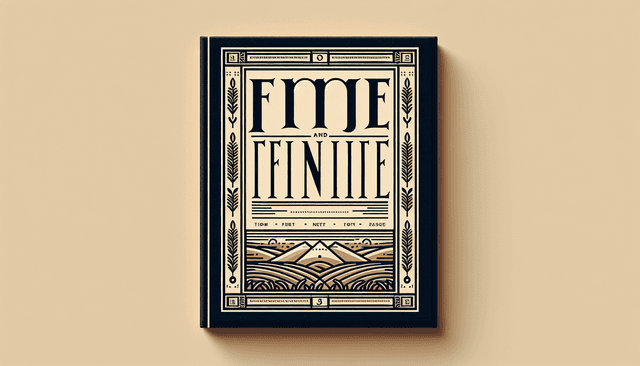Table of Contents
Choosing the right font for your book cover can feel a bit overwhelming, right? With so many styles and options out there, it’s easy to get lost in a sea of typography, leaving you unsure if what looks good will actually work for your audience.
But don’t worry! Stick around, and I promise you’ll gain a clear understanding of the best fonts for book covers, helping your masterpiece stand out on the shelf or online.
We’ll explore everything from top recommended fonts to common mistakes, along with tips to ensure your font choice perfectly complements your book’s message and genre. Let’s dive in!
Key Takeaways
Key Takeaways
- Choose a font that reflects your book’s genre and theme for better audience engagement.
- Serif fonts work well for literary and historical genres, while sans serif fonts suit modern themes.
- Script fonts can add personality to romance or children’s books but should be used sparingly.
- Maintain readability by testing font size and weight; clarity is key for grabbing attention.
- Consider your target audience’s preferences when selecting font styles.
- Combine decorative fonts for titles with simpler fonts for subtitles or author names for balance.
- Utilize free resources like Google Fonts and DaFont, or invest in paid options for a unique touch.
- Always check font licensing for commercial use to protect your work.

Top Recommended Fonts for Book Covers
Choosing the right font for a book cover is crucial as it sets the tone for the entire reading experience. The right font not only attracts potential readers but also conveys the essence of the story before they even turn the first page. Let’s dive into some of the top recommended fonts that can elevate your book cover design.
Serif Fonts
Serif fonts are often seen as classic and trustworthy, making them perfect for literary genres or historical novels. These fonts, which feature small decorative strokes at the ends of their letters, provide a sense of formality and tradition. Popular serif options include Libre Baskerville and Playfair Display, both of which add elegance to any cover.
When designing your book cover, consider using a serif font for the title and a simpler sans serif for the subtitle or author’s name. This creates a visually appealing hierarchy that guides the reader’s eye. Don’t be afraid to play with sizes and spacing to find the perfect balance!
Sans Serif Fonts
If you’re looking for a modern vibe, sans serif fonts might be your go-to choice. These fonts are clean, straightforward, and often considered more legible, especially in smaller sizes. Fonts like Montserrat or Open Sans provide a fresh look suitable for contemporary themes.
Using a sans serif font can make your book appear friendly and inviting. They work exceptionally well in genres such as self-help or modern romances. Plus, don’t hesitate to experiment with bold weights to create emphasis where necessary; think about what grabs your attention on a shelf!
Script Fonts
Script fonts can bring a sense of personality and flair to your cover, making them ideal for more intimate or artistic works. However, moderation is key—too much script leads to chaos! Fonts like Great Vibes and Lobster can add a whimsical touch that resonates well with romantic or children’s books.
To maintain readability, consider using script elements sparingly—perhaps just for the title while keeping the rest of the text in a clean sans serif or serif font. This approach ensures elegance without sacrificing clarity.
Display Fonts
Display fonts are the wild cards of font selection! These eye-catching fonts can go way beyond traditional typefaces and often include unique designs and decorations. They are perfect for genres that rely heavily on aesthetics, such as fantasy or graphic novels. Consider options like Bebas Neue or Impact for a bold statement.
While display fonts are fantastic for grabbing attention, it’s essential to ensure that they still align with your book’s theme. Use them for titles or subtitles, but stick to simpler fonts in the body text to keep the message clear.
Characteristics of a Good Book Cover Font
Not all fonts are created equal, especially when it comes to book covers. The ideal font does much more than just look good—it serves several key functions that can significantly influence a reader’s first impression. Let’s explore the characteristics that define a good book cover font.
Readability
Above all else, your font must be readable. After all, you want potential readers to not only notice your book but also understand its title and author. Aim for clarity, especially from a distance; if the text is difficult to read, it could be a turn-off.
Test your font choices by printing them out in different sizes and viewing them from a few feet away. If you squint, it’s time to find something new. Remember, a well-chosen font can enhance the overall appeal of the book cover while remaining easy on the eyes.
Style and Genre Fit
Your chosen font should reflect the overall style and genre of your book. A playful, whimsical font might perfectly suit a children’s book but would likely confuse readers expecting a serious crime thriller. Identifying the tone of your work will guide you to the right typeface.
Do some research on popular fonts in your genre and analyze how they affect the reader’s perception. Fonts are more than just letters; they can tell a story of their own before the first word is read.
Font Weight and Size
The weight and size of your font can drastically impact how your cover is perceived. Bolder fonts can attract attention but may also overpower subtler designs. Conversely, lighter fonts can lend an air of elegance but might lose clarity if not sized correctly.
Experiment with different combinations to see what works best for your design. Play with hierarchy by varying size and weight between the title and subtitle to create a visually appealing layout that draws readers in.

Popular Font Choices by Genre
Choosing the right font goes beyond aesthetics—it’s critical to match your font choice with your book’s genre.
This creates an immediate connection with your potential readers, allowing them to have an idea of what to expect.
Fiction Fonts
In fiction, fonts like Georgia or Raleway are often favored.
These fonts balance elegance with readability, making them a perfect choice for novels that delve into complex narratives.
Readers are likely to appreciate a classic serif font that subtly hints at the depth of the story contained within the pages.
Non-Fiction Fonts
For non-fiction, clarity is key, and that’s where sans serif fonts like Roboto and Arial shine.
These fonts provide a straightforward look, conveying information without distractions, which is essential in instructional or informative works.
Your font should facilitate quick comprehension, so readers can easily absorb the facts and insights you present.
Romance Fonts
Romance novels often benefit from softer, more whimsical fonts like Merryweather or script styles such as Dancing Script.
These fonts evoke emotions and charm, appealing to readers looking for love stories filled with passion.
Using these types of fonts can make your cover inviting, drawing readers into the emotional journey you’ve crafted.
Thriller Fonts
Thrillers demand attention, and that’s where bold fonts like Bebas Neue come into play.
These impactful fonts stir excitement and urgency, making a promise of suspense and drama throughout the pages.
Your choice of font can set a chilling atmosphere right from the first glance, inviting readers into a world of intrigue.
Children’s Books Fonts
For children’s books, readability and fun are the top priorities, so fonts like Fredoka One and Comic Neue work wonders.
The playful nature of these fonts aligns perfectly with the vibrant illustrations and stories that engage younger readers.
A friendly, rounded font can make a book feel more welcoming, which is crucial in attracting curious little minds!
Tips for Choosing the Right Font
Selecting the right font might feel overwhelming, but a few guiding principles can make the process smoother.
Let’s explore some helpful tips that can lead you to a perfect match for your book cover.
Considering Target Audience
Your target audience plays a critical role in determining font choice.
Think about who your readers are and what appeals to them—different demographics can respond distinctly to various styles.
For example, a sophisticated audience might appreciate elegant serif fonts, while younger readers might prefer something more playful.
Keeping it Simple
When in doubt, simpler is usually better.
Trying to impress readers with fancy fonts can backfire, as overly complicated choices can turn readers off instead.
Stick to a clean, clear design that serves the book cover’s purpose without overwhelming the viewer’s eye.
Pairing Fonts
Pairing fonts is an art—combining a decorative font for the title with a legible font for the subtitle or author’s name can create balance.
Just make sure they complement each other rather than compete for attention, ensuring the overall design feels cohesive.
Experiment with different combinations to find the dynamic duo that resonates with your book’s vibe.
Free and Paid Font Resources
Finding the right font doesn’t have to drain your wallet.
There are plenty of resources available where you can get both free and paid fonts suitable for your needs.
Websites for Free Fonts
If you’re looking for free fonts, sites like Google Fonts and Dafont are fantastic starting points.
These platforms offer a wide range of styles, allowing you to select the perfect look without spending a dime.
Just be sure to check the licensing to ensure that commercial use is allowed if you’re planning to sell your book!
Best Paid Font Options
When it comes to paid options, websites like Fonts.com and Creative Market provide a treasure trove of unique fonts.
Investing in a quality font can set your cover apart from the competition, giving it a professional touch.
These paid fonts often come with better customer support and a wider range of styles to choose from.
Font Licensing Considerations
Understanding font licensing is crucial, especially if you plan to use the font for commercial purposes.
Some fonts are free for personal use only, while others require a one-time purchase or subscription for commercial use.
Always read the fine print to ensure you are not infringing on any rights, safeguarding your creative efforts!

Case Studies of Successful Book Covers
Analyzing successful book covers can provide valuable insights into what works in the world of typography.
Through case studies, we can see real-life examples of how font choices and cover design strategies have led to sales success.
Analysis of Best-Selling Books
Take a look at best-selling titles like Where the Crawdads Sing by Delia Owens.
The font used on the cover is a simple serif that conveys elegance and mystery, echoing the book’s themes.
Similarly, Becoming by Michelle Obama uses clean, modern sans serif typography.
This choice reflects the contemporary and personal narrative illustrated in the memoir.
Trends in Book Cover Typography
Recent trends show a shift toward minimalist designs with bold typography, a great example being The Silent Patient by Alex Michaelides.
The use of large, striking text conveys urgency and draws the reader’s eye instantly.
Another trend is the blending of fonts, such as using a playful display type for the title paired with a classic body font, as seen in The Book Thief.
These examples demonstrate that successful book covers strike a balance between creativity and readability while appealing directly to their target audience.
Common Mistakes to Avoid
Even the best designers can make mistakes when selecting fonts for a book cover.
Understanding common missteps can save you from potential pitfalls and make your design shine!
Overly Complicated Fonts
One of the most prevalent mistakes is choosing overly complicated fonts.
While it may be tempting to select an intricate typeface that looks stunning, it often leads to confusion.
Readers should never have to work hard to decipher the title—simplicity usually wins the day.
Poor Readability
Remember, your font needs to be legible at various sizes and distances.
If potential readers can’t read your title from across the room, they might never pick up the book.
Always test fonts in both small and large formats to ensure clarity first and foremost.
Ignoring Genre Conventions
Another common pitfall is ignoring genre conventions.
What works for a children’s book may not resonate with a thriller audience.
Keep in mind that different genres set different expectations, and choosing a font that reflects those nuances is crucial.
Future Trends in Book Cover Fonts
Book cover design is an evolving field, and staying ahead of trends can set you apart from the competition.
As we look to the future, several exciting developments are already shaping font selection for book covers.
Predictions for New Styles
Predictions suggest a move toward even more personalized typography, with authors utilizing custom fonts that reflect their unique voice.
As design software becomes more accessible, expect to see more self-published authors creating bespoke fonts to craft their book covers.
This will add a layer of authenticity and individuality that could resonate well with readers.
Impact of Digital Formats on Font Choices
With the rise of eBooks, the impact of digital formats on font choices is undeniable.
Designers are increasingly considering how fonts will appear on various screens, tailoring their choices for better readability across platforms.
It’s a balancing act between aesthetic appeal and functional legibility, sending traditional rules packing as the digital world evolves.
Conclusion: Design Your Cover with Confidence
In summary, choosing the right font for your book cover is a blend of art and strategy.
Focus on readability, genre conventions, and audience expectations to craft a design that draws readers in.
Keep it simple and consider pairing different fonts for a balanced look.
As you dive into free and paid resources for your font selection, remember to pay attention to licensing agreements to keep your creative efforts safe.
By learning from successful case studies and avoiding common mistakes, you can design a book cover that stands out, reflects your story, and keeps readers captivated from the very first glance.
FAQs
The best font types for book covers include serif fonts for classic appeal, sans serif for modern designs, script for elegant touches, and display fonts for impactful statements, catering to different genres and styles.
Consider the conventions of the genre. For instance, romantic novels may benefit from elegant script fonts, while thrillers might use bold, sans serif fonts for a more intense look.
Common mistakes include using overly complicated fonts that hinder readability, ignoring genre norms, and not considering the target audience, which can lead to an ineffective cover design.
Websites like Google Fonts or DaFont offer free fonts, while platforms like Adobe Fonts provide a range of paid options. Always check licensing agreements to ensure appropriate usage.



